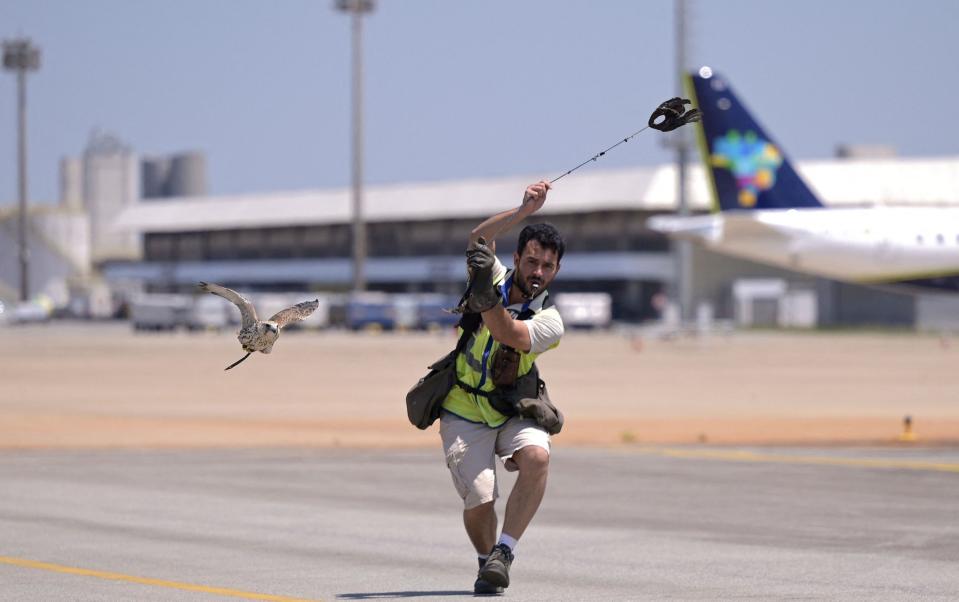There are many reasons why a flight may be delayed. Bad weather and mechanical problems are frustrating, but unlikely to surprise. Even more terrifying is the sight of the little penguin frantically trying to cross the runway.
This was the scene at Wellington Airport last month. A corora, or little blue penguin, was spotted seconds before take-off by a Chathams Air pilot, who described the creature as “not particularly happy” to be on the 50°C runway. Airport staff rushed to collect the little bird as passengers looked on, before it was taken to Wellington Zoo for rehabilitation.


Animal invasions on the runway are more common than you might think – and it’s not just birds that cause problems. In Alaska, musk ox, caribou and moose were known to roam the tarmac. In Milan, hares on the runway play a lot with radar systems. Researchers at University College Cork report around 100 fruit bat strikes a year in Australia.
In Florida, reptilian runway invasions are common. There are an estimated 230 alligators living in Orlando International Airport’s 13,000 acres of water—many of which choose unfortunate moments to move around the site. In 2018, a Spirit Airlines flight was delayed by one particularly slow creature, which crossed the taxiway as the plane landed.
Bodies of water can be very problematic. John F Kennedy Airport in New York has seen numerous runway incursions by diamondback terrapins, which, in the summer months, have taken to using the tarmac as a mating ground. The turtles correctly identify that the airport is above the high tide line, making it a safer place to lay eggs. But they don’t seem to notice the jets. After multiple flight delays, airport authorities installed plastic tubing to deter the turtles.
For most passengers, animal contact is a great diversion. Airports, however, see wildlife as a serious problem. The flightless Korora was cute; a large flock of seagulls could cause great damage. Bird strikes occur with relative frequency, and US Airways Flight 1549 – “the Miracle on the Hudson” – lost engine power due to a collision with geese.
The UK Civil Aviation Authority estimates that wildlife strikes cost the industry £900 million a year, with each incident averaging around £27,000. Most collisions cause only minor damage, but larger flocks – or one large bird – can cause serious problems. In 2017, an AirAsia X flight lost an engine after passengers reported hearing “four or five bangs”. The cause was a suspected bird strike.


Airports have reported an increase in the number of strikes over the past few decades, due to more general air travel, and improved reporting procedures. Population growth among “pest” animals such as deer and geese is also a contributing factor.
In fact, runway conditions are particularly attractive to certain types of wildlife. The grass bordering airfields is perfect for rodents and insects, attracting birds of prey, starlings and deer. The foliage is also suitable for grazing by geese.
In response, airports have gotten creative. The solutions range from the explosive (shooting paintballs at interlocking creatures) to the dog (hiring Bordie Collies as a wildlife-proof security team). Others have turned to lasers, fencing and misleading lighting.
Often, the environment is managed more than the wildlife itself. Pools are filled; reduced grass areas. In Salt Lake City, pigs are deployed to eat the eggs of the local bird population. Distress calls of specific bird breeds are sometimes played across an airfield to scare off potential nesters.
At Istanbul Airport, preventing bird strikes is taken so seriously that an advanced radar system has been installed, providing live readings that show the size, location and movements of nearby flocks. Pilots and air traffic controllers have access to the data and can change landing patterns accordingly.
In the United States, a more macabre method is occasionally used. Apparently, plastic owls, which were once in airport windows as a deterrent to low-flying vultures, ravens and seagulls, do not move. A 2009 study found that displaying the corpses of dead birds is an effective – if terrifying – way to protect others.
Mammals have similar problems. From 1990 to 2019, 1,210 civilian aircraft were involved in collisions with deer, causing £30 million in damage. In Idaho, the population of white-tailed deer was so affected that officials opened the runway to hunters, who were encouraged to kill the animals using archery equipment. Despite hours of hunting, no deer were killed.
Fortunately, however, the solutions do not always have to be fatal for the mediators. In 2017, a bearded seal was found sitting on the runway at the remote Utqiaġvik airport in Alaska. It was loaded onto the back of a sled, then strapped onto the back of a snow machine, and driven back into the frozen landscape. And the corora in Wellington – only six weeks old – is reported to be healthy, enjoying his recovery at the animal sanctuary.
“We think it could be crawling under the fence,” says Wellington Airport wildlife officer Jack Howarth. “We’ve done some penguin testing to keep our turned friends out of trouble in the future.”